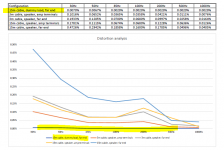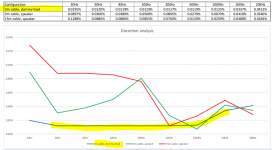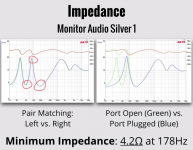...If you have a sound interface, connect it to your dummy load with and without cable. See what you get. Yes, take all proper precautions to ground properly. You will still see distortion. It’s not the cable that makes the distortion visible - imagine a very short 5cm cable. It won’t be the same as long cable - it will be close to same as no cable. The effect is caused by the cable not that the cable makes it easier to see...
In post 66 behind a 15 meter cable dummy load show no problem and second test in post 214 behind a 3 meter cable dummy load is still okay so doesn't that point to speaker device.
Attachments
Thanks Byrtt, that line on the bottom was flat and colored the same as the axis I missed it looking at it on my phone.
I will have to repeat my measurements with a balanced input line.
I will have to repeat my measurements with a balanced input line.
Speaker impedance non-linearity seems to be noticeably higher below 200Hz with the longer cable.
Below is quick and dirty try and is really not very flat and elegant but should you have all those weird values laying around then the plugged port version could be remeasured as a trial case.
Attachments
So this was simulation, not actual measurement sweep to find resonances ?.About 15 years ago I ran the numbers using 10 amps and some zip insulation modulus. IIRC, the effect was somewhere in the 7 to 9 orders of magnitude below.
Dan.
You probably meant that estimate to be evidence that the effect will be inaudible; sadly the true believers will take it as evidence that their hearing is much sharper than science predicts.jneutron said:About 15 years ago I ran the numbers using 10 amps and some zip insulation modulus. IIRC, the effect was somewhere in the 7 to 9 orders of magnitude below.
Think of it this way.So this was simulation, not actual measurement sweep to find resonances ?.
Dan.
A car odometer measures tenths of a mile, say 530 feet.
3 orders down is.53 feet, say 6 inches.
6 orders down is .006 inches, 6 mils.
7 is .6 mils, one fifth the thickness of a newspaper sheet.
9 orders down is 6 millionths of an inch.
So, what do you think the chances of measuring an object 6 millionths of an inch accurately using an odometer in your car is?
Also, a wire physical movement will be at twice frequency, because a parallel pair driven will only see forces at twice rate, only repulsion. Look at the measurements already posted here, numbers in the .02 percent range barely seen using the equipment. Run that number...
1 percent is 2 orders of magnitude down.
.1% is 3
.01%is 4
.001% is 5
.0001% is 6
.00001% is 7
.0000001% is 9.
So you are asking about measurements from one thousand to one hundred thousand times better than what was just displayed. Look at the problems that rose just trying to measure 4 orders down...
To sum up, the task is audibility of a second harmonic at lower than .00001%, and possibly lower than .0000001%. (I'm having problems just keeping track of the zero's..sheesh)
DF: yes, intent was level as too low. However remember that some audio guru's point to line cord inrush causing cordage movement as an indicator that "it could happen", but they conveniently neglect the levels involved to gain followers.
Jn
Last edited:
I wonder about the sense of ultra low distortion amplifiers.
Yes one can get ultra low on a dummy load.
However, as soon as the load is a real speaker distortion appears because of the speaker non linearities.
Yes one can get ultra low on a dummy load.
However, as soon as the load is a real speaker distortion appears because of the speaker non linearities.
An important point is the nature of distortion here. Here is what I think.
As we can see on the measured spectrums, speaker's non-linearity leads to mostly the low-order harmonics increase - H2 (asymmetry) and H3 ("compression").
On the other hand, an amplifier can add much more evil things - for example, crossover distortion, if not addressed properly, produces a lot of high-order "garbage".
The way amplifier handles the transients is also important - low performance in this domain may also lead to high order harmonics produced at the output.
Simplifying things, the role of the amplifier's OPS (voltage drive) is to provide the voltage to the speaker, allowing as much current as the speaker requires at every given point in time (PSU capabilities are also important here). The role of the front-end (voltage gain stages) is to control the OPS for doing its job at the required swing and as close according-to-the-input-signal as possible. The engineering task is to arrange both things in some better way (including economical considerations 😉).
Plus - some speakers produce less distortion than average. Then, an amplifier, driving them, must be even more accurate.
Then we come to the point of the way the human ear percepts the distortion.
Low order harmonics are much less noticeable than the high-order ones. So, even if an amplifier produces some noticeable levels of H2, H3 (sometimes some lower amounts of H4, H5), it must be very clean at the higher orders for sounding good.
And then we come to the point of some personal preferences, beliefs, "religion", etc. 🙂
Anyway, the best amplifier is the one you don't hear - either its distortion is masked by the speaker or it's just low enough throughout the spectrum 😉
As we can see on the measured spectrums, speaker's non-linearity leads to mostly the low-order harmonics increase - H2 (asymmetry) and H3 ("compression").
On the other hand, an amplifier can add much more evil things - for example, crossover distortion, if not addressed properly, produces a lot of high-order "garbage".
The way amplifier handles the transients is also important - low performance in this domain may also lead to high order harmonics produced at the output.
Simplifying things, the role of the amplifier's OPS (voltage drive) is to provide the voltage to the speaker, allowing as much current as the speaker requires at every given point in time (PSU capabilities are also important here). The role of the front-end (voltage gain stages) is to control the OPS for doing its job at the required swing and as close according-to-the-input-signal as possible. The engineering task is to arrange both things in some better way (including economical considerations 😉).
Plus - some speakers produce less distortion than average. Then, an amplifier, driving them, must be even more accurate.
Then we come to the point of the way the human ear percepts the distortion.
Low order harmonics are much less noticeable than the high-order ones. So, even if an amplifier produces some noticeable levels of H2, H3 (sometimes some lower amounts of H4, H5), it must be very clean at the higher orders for sounding good.
And then we come to the point of some personal preferences, beliefs, "religion", etc. 🙂
Anyway, the best amplifier is the one you don't hear - either its distortion is masked by the speaker or it's just low enough throughout the spectrum 😉
You are making the assumption that high quality sound reproduction is the aim; that is not everyone's aim, as some prefer a little added distortion.vzaichenko said:Anyway, the best amplifier is the one you don't hear - either its distortion is masked by the speaker or it's just low enough throughout the spectrum
Good amplifiers when they are far away from their limits do not distort more on so called difficult loads (like loudspeakers) than on dummy loads.I wonder about the sense of ultra low distortion amplifiers. Yes one can get ultra low on a dummy load. However, as soon as the load is a real speaker distortion appears because of the speaker non linearities.
For ( cher ami ) I think you missed the point.
Look at the measurements from Valery. They prove that a very low distortion amplifier does have a significant distortion at the terminals of a loudspeaker.
See measurements:
15m cable, dummy load, far end 0.0020% THD @ 200 Hz
3m cable, speaker, far end 0.1% @ 200 Hz
15m cable, speaker, far end 0.18% @ 200 Hz
Look at the measurements from Valery. They prove that a very low distortion amplifier does have a significant distortion at the terminals of a loudspeaker.
See measurements:
15m cable, dummy load, far end 0.0020% THD @ 200 Hz
3m cable, speaker, far end 0.1% @ 200 Hz
15m cable, speaker, far end 0.18% @ 200 Hz
Those measurements show:
- a good amplifier has low distortion
- a cable has low distortion
- a resistor has low distortion
- a speaker has a somewhat nonlinear impedance
- the amplifier cannot correct this
They do not show that "a very low distortion amplifier does have a significant distortion at the terminals of a loudspeaker". The amplifier has little distortion; it is the speaker which distorts.
- a good amplifier has low distortion
- a cable has low distortion
- a resistor has low distortion
- a speaker has a somewhat nonlinear impedance
- the amplifier cannot correct this
They do not show that "a very low distortion amplifier does have a significant distortion at the terminals of a loudspeaker". The amplifier has little distortion; it is the speaker which distorts.
From post #66 where Valery gives a neat summary of his measurements:very interesting, at how much dbv or watts are those measurements?
All measurements are done at 4V RMS at the output of the amplifier.
For ( cher ami ) I think you missed the point.
Look at the measurements from Valery. They prove that a very low distortion amplifier does have a significant distortion at the terminals of a loudspeaker.
See measurements:
15m cable, dummy load, far end 0.0020% THD @ 200 Hz
3m cable, speaker, far end 0.1% @ 200 Hz
15m cable, speaker, far end 0.18% @ 200 Hz
very interesting, at how much dbv or watts are those measurements?
Wait a minute wasn't it stated down the road that vzaichenko measurering method is actually measuring speakers non linearity distortion, so how can that suddenly be interpreted to be the low distortion amp is the distortion problem here, those numbers is telling if we want low distortion as possible have as short a cable as possible and maybe also as Tournesol told about using resonance and inductance linearization networks in speaker end will help damp out those non linarites.
I have never interpreted such a thing.so how can that suddenly be interpreted to be the low distortion amp is the distortion problem here
It is clear to me the speaker is the distortion problem.
Maybe there is a language problem? To say that an amplifier has a distortion implies that the amplifier is the source of that distortion.
Each amp have a feedback, not regarding Global NFB loop around whole amp or local intrinsic loop in the OPS of the so called No-GNFB amps.Simplifying things, the role of the amplifier's OPS (voltage drive) is to provide the voltage to the speaker, allowing as much current as the speaker requires at every given point in time (PSU capabilities are also important here). The role of the front-end (voltage gain stages) is to control the OPS for doing its job at the required swing and as close according-to-the-input-signal as possible. The engineering task is to arrange both things in some better way (including economical considerations 😉).
1. The role of the front-end is to compare something from the input and something from the output and after some comparison work provide OPS control signal.
2. No-GNFB amps have intrinsic OPS in-stage feedback and its OPS controls himself’s directly comparing base(gate) and emitter(source) signals, so the front-end could provide only control signal.
Keeping in mind comparing for the GNFB-looped amps it’s better to have as much loopgain as possible and as high frequency as possible.
For the No-GNFB amps it’s better to have as high OPS current gain as possible - so high transconductance and/or high-current device are preferable.
At our case amp’s front-end compares signal from the improper point.
Your speaker above mechanical resonant frequency consumes much more current than at mechanical resonant frequency, say 10 times more. Because of this small wire resistanse (being outside GNFB control loop) makes more voltage drop (accordingly to the Ohm’s law) resulting as more distortion above resonant frequency and also makes those distortion visible for your measuring equipment.
If the measured distortion at the ouput of the amp emanates from the non-linearity of the loudspeaker, it means that the distortion voltage is due to the current through the impedance of amp output. For most amps, this impedance is very low, typically less than 0.1 Ohm.
The distortion was measured at the speaker terminals, NOT at the amplifier output.
READ post #66.
READ post #66.
- Status
- Not open for further replies.
- Home
- Amplifiers
- Solid State
- Speaker cables don't influence harmonic distortion!



